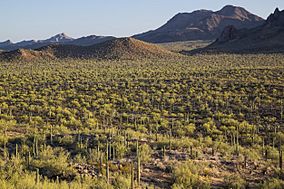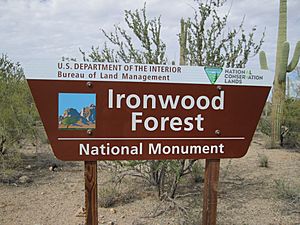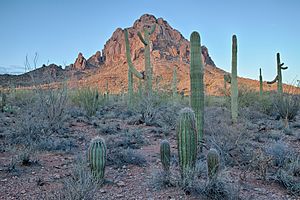Ironwood Forest National Monument facts for kids
Quick facts for kids Ironwood Forest National Monument |
|
|---|---|

Saguaro forest in Ironwood Forest National Monument
|
|
| Location | Pima County & Pinal County, Arizona, United States |
| Nearest city | Tucson, AZ |
| Area | 129,055 acres (52,227 ha) |
| Established | June 9, 2000 |
| Governing body | U.S. Bureau of Land Management |
| Website | Ironwood Forest National Monument |

The Ironwood Forest National Monument is a special protected area in the Sonoran Desert of Arizona. It was created by President Bill Clinton on June 9, 2000. This monument is now managed by the Bureau of Land Management, which is a part of the U.S. government.
The monument covers a huge area of about 129,055 acres. This includes many ironwood trees, which are very important to the desert. You can also find two types of plants and animals here that are endangered, meaning they are at risk of disappearing forever. Scientists have found more than 200 ancient sites from the Hohokam and Paleo-Indian people within the monument. These sites are between 600 and 1450 years old.
Contents
Plants and Animals of the Desert

Amazing Desert Plants
The Ironwood Forest National Monument is home to many different kinds of plants. In the higher parts of the monument, you'll find pinyon-juniper trees. The lower areas are part of the Sonoran Desert, which is a unique ecoregion. One interesting tree here is the elephant tree (Bursera microphylla). There are also small groups of the endangered Nichols turk's head cactus. These cacti grow in rocky areas with lots of limestone.
The Mighty Ironwood Tree
The desert ironwood (Olneya tesota) is a tree that lives for a very long time. Some of these trees are thought to be more than 800 years old! The ironwood tree is a keystone species. This means it's super important to its environment. It acts like a "nurse tree" by giving shade and protection to young plants. This helps other seedlings grow in the hot desert, where temperatures can be over 105°F (41°C).
Ironwood trees also provide shade and places for birds to rest. Their pretty lavender flowers give nectar to bees and other insects. Animals also eat the flowers and the bean pods that grow from them.
Ancient Plant Life
Scientists have studied the plants that lived in the Waterman Mountains area of the monument long ago. They found out what plants were common during the last glacial period, called the Late Wisconsin period. Back then, the main trees were Utah juniper (Juniperus osteosperma), single-leaf pinyon (Pinus monophylla), and redberry juniper (Juniperus pinchotii).
Desert Animals and Their Lives
Many animals live in the Ironwood Forest National Monument. Proclamation 7320, which created the monument, said that 674 plant and animal species were found in the Silver Bell Mountains nearby. This included 64 types of mammals and 57 types of birds. More recent studies have found 560 plant species. Birdwatchers have also seen more than 80 kinds of birds, both those that live there all year and those that migrate.
The Lesser Long-Nosed Bat
Researchers have found one endangered lesser long-nosed bat (Leptonycteris curasoae) and a place where bats rest at night within the monument. These bats are special because they migrate very long distances. They can travel over 1,600 miles (2,575 km) from places like Jalisco, Mexico. The monument might be an important stop for them to eat during their spring travels.
Desert Bighorn Sheep
The Arizona desert bighorn sheep herd in the monument is the last group of these sheep in southeastern Arizona. They first came to North America a very long time ago, during the Pleistocene epoch. You might also find the cactus ferruginous pygmy owl here. This small owl was once listed as an endangered species.
A Look Back in Time: History
The Hohokam people were the first miners in this area. They dug for a type of rock called andesite, which was great for making tools like agave knives. These knives, made from andesite found in the monument, have been discovered far away, even in Mexico near the Gulf of California.
Later, around 1850, people started mining for silver and copper in the Silver Bell Mountains. This mining still happens today. Interestingly, female bighorn sheep like to have their babies in the high, steep, and open areas near these mines. This helps them see and escape from predators.
Fun Things to Do
The Ironwood Forest National Monument is used for many different activities. You can enjoy recreation, cattle grazing, and even some mining. However, new mining claims and driving off-road are not allowed.
Cattle have been grazing here for at least 125 years. Today, only a small number of cows are allowed. This helps protect the land. It's important to know that domestic sheep and goats are not allowed. This rule helps protect the wild bighorn sheep.
The monument doesn't have much surface water, but there is plenty of water underground. Ranchers keep more than 80 man-made water sources for their cattle. The Arizona Game and Fish Department also maintains 14 water sources. All this water helps support many animals like birds, mule deer, coyotes, foxes, bobcats, and mountain lions.
Images for kids
-
Silver Bell Mine is surrounded by ironwood forest to the north and the Tohono O'odham Indian Reservation to the south.
-
Hohokam ruins in the Los Robles Archaeological District.
-
Hohokam petroglyphs at Cocoraque Butte.
-
Saguaro forest with Ragged Top in the background.







